Giochi dell'Oca e di percorso
(by Luigi Ciompi & Adrian Seville)
(by Luigi Ciompi & Adrian Seville)

|
Giochi dell'Oca e di percorso
(by Luigi Ciompi & Adrian Seville) |

|
 |

Torna alla ricerca giochi (back to game search) |
 |
| Race (A) to the Gold Diggins of Australia | ||
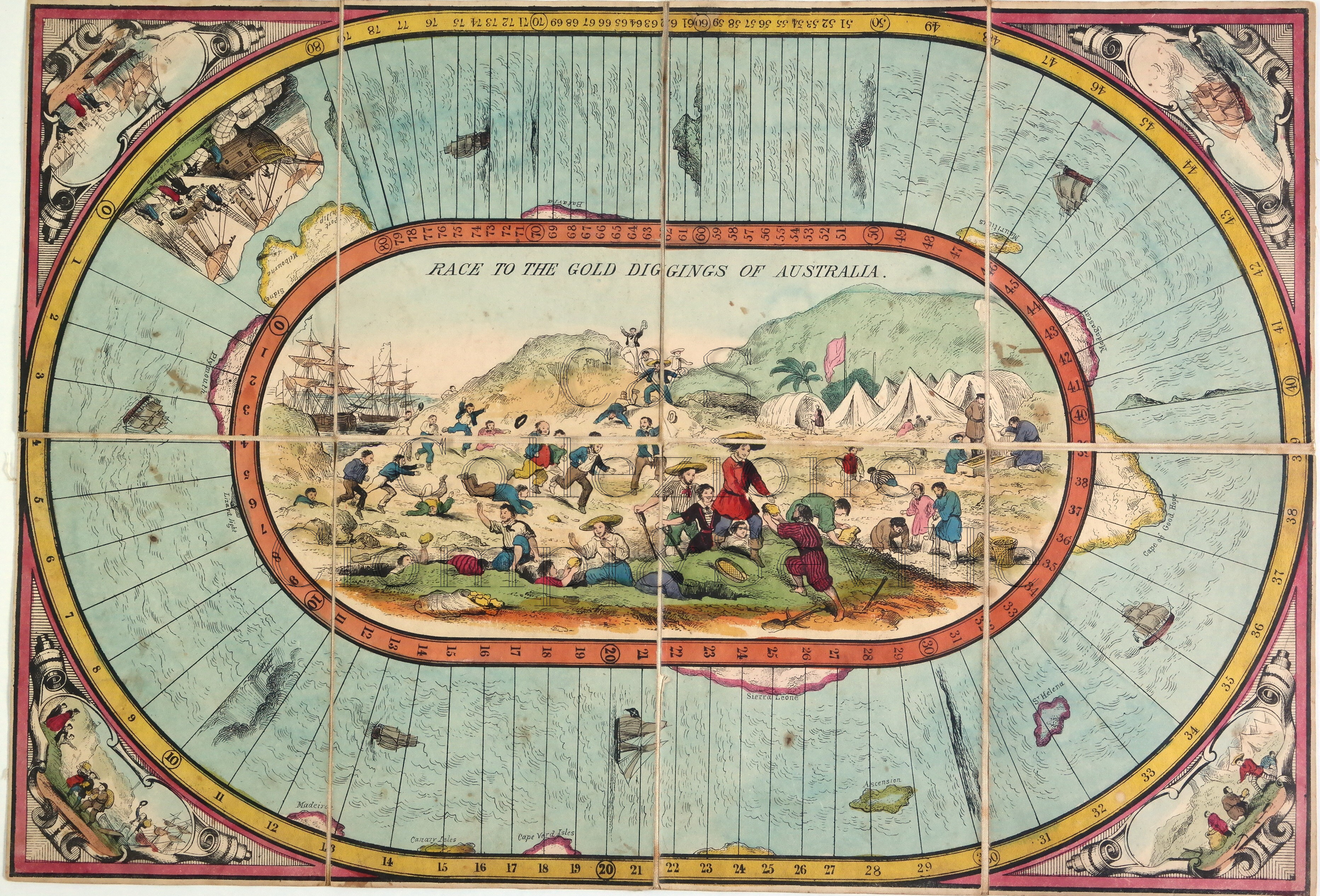 |
Versione stampabile
 |
Invia una segnalazione

|
 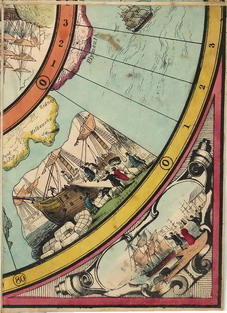 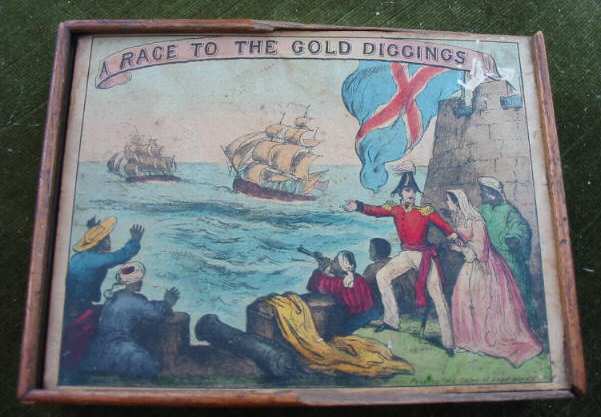   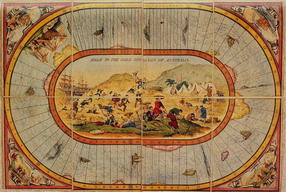 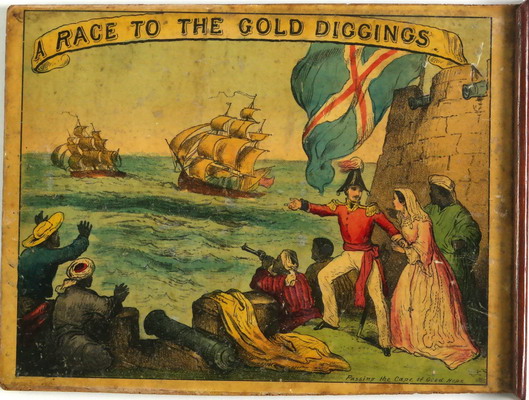  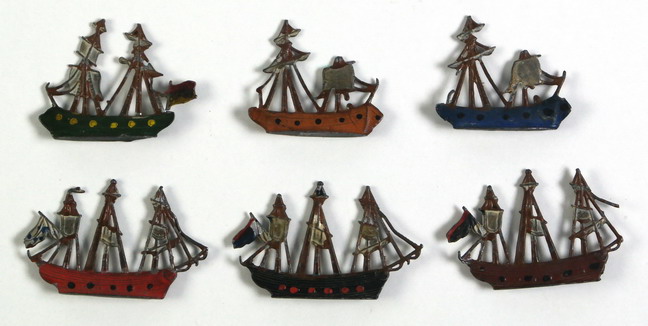 |
primo autore: | Non indicato |
| secondo autore: | Anonimo | |
| anno: | 1850/69 | |
| luogo: |
Inghilterra |
|
| periodo: | XIX secolo (3°/4) | |
| percorso: | Percorso di 80 caselle numerate | |
| materiale: | carta incollata su tela (engraving on paper with linen backing) | |
| dimensioni: | 330X495 | |
| stampa: | Litografia colorata a mano (hand-coloured engraving) | |
| luogo acquisto: | ||
| data acquisto: | ||
| dimensioni confezione: | ||
| numero caselle: | 80 | |
| categoria: | Infanzia, educazione, pedagogia, favole e fiabe | |
| tipo di gioco: | Gioco di percorso | |
| editore: | Non indicato | |
| stampatore: | Non indicato | |
| proprietario: | Collezione A. Seville | |
| autore delle foto: | A. Seville | |
| numero di catalogo: | 733 | |
| descrizione: |
Gioco di 80 caselle numerate. REGOLE: non riportate sul tavoliere. CASELLE: mute. REFERENZA 1 Board game, "Race to the gold diggings of Australia" , linen/ wood/ paper, England, 1850–1869. A boxed children’s board game. The game board consists of a hand-coloured lithograph mounted on linen, with a printed rule card, six painted ship pieces with stands, and a cardboard teetotum, all contained in its original wooden case with illustrated lid. Players move around an oval track representing the sea voyage from Britain to Australia. The centre is a scene of miners at the goldfields and in each corner small vignettes depict travels, success on the diggings and bags of gold. The illustration on the box lid shows ships ‘Passing the Cape of Good Hope ‘. W 49.5cm L33.0cm (1). In March 1851, Edward Hargraves wrote to the Sydney Morning Herald to announce that he had found payable gold just outside the New South Wales town of Bathurst. By 15 May over 300 diggers were in the area prospecting for gold and the Australian gold rush had begun. The following month further discoveries were made at Clunes in Victoria and later Warrandyte, Bunninyong and Ballarat. By the end of the year half the adult male population of the colony was at the diggings. With so many people leaving for the goldfields, many businesses found it hard to keep operating. Ship crews deserted, leaving vessels stranded in port, shepherds left their flocks, government officials, clerks, teachers and policemen left their jobs in the excitement. Soon they were joined by thousands of immigrants from Europe, America, China and New Zealand keen to try their luck. Between 1852 and 1861 over 342,000 people arrived, often enduring appalling conditions on overcrowded ships. Conditions were not much better on land as tent cities sprang up to accommodate the burgeoning population and the cost of food and necessities skyrocketed. Although there were some remarkable discoveries on the goldfields, few people made their fortune and most drifted back to towns and cities looking for work. Some of the immigrants returned to their countries of origin but the majority stayed. Australia ’s first gold rush transformed the colonies. Convict transportation to the eastern colonies ceased, the population more than doubled, agriculture expanded and new industries were established. In these circumstances it is not surprising that the 1850s obsession with making a fortune at the diggings found its way into children’s games such as the Race to the gold diggings of Australia. The detailed colour illustrations reveal contemporary attitudes to the Australian gold rush. A circular track on the board simulates the journey by sea from England to Australia. Players must embark at Plymouth, make the hazardous ocean voyage, land at Port Philip [sic] and journey to the diggings. The winner is the first to arrive in Australia. Naturally there are large gold nuggets to be found as soon as the happy immigrants set foot on land. It is interesting that the miners’ clothing suggests that they have come from many parts of the world, not just England. The board shows prospectors digging while women and children gather outside their tents. Ships are anchored in a nearby bay, a stone’s throw from the gold diggings. At the time this game was produced, board games generally had a moralistic slant, emphasising the virtues of hard work, thrift and economy. With its emphasis on instant wealth in a far off land, this game runs counter to that trend, providing children with a graphic reminder of the excitement and avarice that the Australian gold rush inspired (2). As a well executed game based on historic events, this object has historic and aesthetic value. It has research potential with its romantic depiction of the voyage to Australia and the prospect of instant wealth. It also reveals the limited understanding hopeful diggers had of Australia’s geography. In excellent condition, it has considerable interpretive potential. The Race to the gold diggings of Australia board game is a rare example of the movable heritage of the first Australian gold rushes, an event that transformed colonial society and laid the foundation of modern Australia. The board game was purchased by the Trustees of the Museum of Applied Arts and Sciences in 1984. Footnotes: (Power House Museum) Bibliography Robyn Annear, Nothing but gold: The diggers of 1852 , Text Publishing, 1999. Geoffrey Blainey, The rush that never ended: a history of Australian mining , Melbourne University Press, 1978 Significance: A guide to assessing the significance of cultural heritage objects and collections , Heritage Collections Council. 2001. Websites: ((1)), ((2)). REFERENZA 2 WHITEHOUSE, Francis Reginald Beaman, (pag. 68): RACE TO THE GOLD DIGGINGS OF AUSTRALIA. A lithograph size 19 in X 13 in, coloured by hand in part, mounted in 8 sections on linen, folded. The rules are printed from type on white paste board. The race track, rules, ivory totum and six lead ships are contained in a mahogany box with slide lid, on which is a coloured print entitled “A Race to the Gold Diggings", showing two ships in full sail passing the Cape of Good Hope. Box measures 7 ¼ in X 5 ½ in X 1 5/8 in. (The gold rush to Australia was from 1851-1853.) Exhibitions: |
|
| bibliografia: |
1) GOODFELLOW, Caroline: "Jeux de société. Le guide du collectionneur des jeux de société depuis le XVIIIe siècle jusqu’à nos jours", (Edizione francese) Carrousel MS, 2001. 2) GOODFELLOW, Caroline: "A Collector's Guide to Games and Puzzles" Secaucus, New Jersey, Chartwell Books-London, Quintet Publishing Limited 1991. 3) GOODFELLOW, Caroline: "The Development of the English Board Game, 1770-1850", in Board Games Studies 1, 1998. 4) SEVILLE Adrian: "The geographical Jeux de l'Oie of Europe." In "Belgeo" 2008 3-4 2008. 5) SEVILLE, Adrian: "The Game of Goose: and its influence on cartographical race games" Journal of the International Map Collectors' Society, Winter 2008 N°115 2008. 6) WHITEHOUSE, F.R.B: "Table Games of Georgian and Victorian Days", Peter Garnett 47, Welbeck Street, London 1951. 7) LIMAN, Ellen: "Georgian and Victorian Board Games: The Liman Collection", Pointed Leaf Press, 2017. 8) NORCIA, Megan A.: "Gaming Empire in Children's British Board Games, 1836-1860". Studies in Childhood, 1700 to the Present. Routledge, 2019. |
|
| "The Development of the English Board Game", 1770-1850 (Caroline G. Goodfellow) | ||
| Games of Amusement. "Table Games of Georgian and Victorian Days". (Francis Reginald Beaman, Whitehause) | ||
Vai alla ricerca giochi Vai all'elenco autori